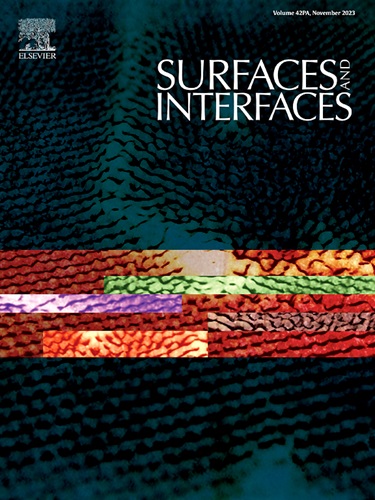Surface strain, oxidation effect, and reconstruction of spherical and faceted Ag and Pd nanoparticles
IF 5.7
2区 材料科学
Q2 CHEMISTRY, PHYSICAL
引用次数: 0
Abstract
Surface strain plays a crucial role in enhancing the performance of nanocatalysts. In this work, the distribution of atomic strain and stress in three different structures (bulk, surface, and nanoparticle) of Ag and Pd was investigated. The atomic strain and stress in bulk structures approach 0 %, while the first atomic layer of surface structures exhibits a significant tensile state. For faceted nanoparticles, the compressive strain is localized along the edges and vertices of the surface, as well as in the inner core region, while tensile strain is observed on the surface facet. The Laplace pressure experienced by spherical nanoparticles of different sizes increases with decreasing radius, induces compressive atomic strain and stress both on the surface and within the interior of nanoparticles. After oxidation, tensile atomic strain and stress are induced in the oxidized surface regions, with the magnitudes increasing proportionally to the oxidation degree. We also developed an energy-dependence diagram for the structural reconstruction of faceted nanoparticles, revealing that the process is driven by surface reconstruction and atomic strain, with a strong dependence on both energy and temperature. These founds in this contribution provide a theoretical basis and insight for the future design of noble metal nanocatalysts.
表面应变,氧化效应,以及球形和面形银和钯纳米颗粒的重建
表面应变对提高纳米催化剂的性能起着至关重要的作用。本文研究了银和钯在三种不同结构(体结构、表面结构和纳米颗粒结构)中的原子应变和应力分布。体结构中的原子应变和应力接近0%,而表面结构的第一原子层表现出明显的拉伸状态。对于面形纳米颗粒,压缩应变集中在表面的边缘和顶点以及内核区域,而拉伸应变则集中在表面上。不同尺寸的球形纳米颗粒所受的拉普拉斯压力随半径的减小而增大,在纳米颗粒表面和内部均产生压缩原子应变和应力。氧化后,在氧化区产生拉伸原子应变和应力,其大小与氧化程度成正比。我们还开发了面向面纳米颗粒结构重建的能量依赖图,揭示了该过程是由表面重建和原子应变驱动的,并且对能量和温度都有很强的依赖性。这些发现为未来贵金属纳米催化剂的设计提供了理论基础和见解。
本文章由计算机程序翻译,如有差异,请以英文原文为准。
求助全文
约1分钟内获得全文
求助全文
来源期刊

Surfaces and Interfaces
Chemistry-General Chemistry
CiteScore
8.50
自引率
6.50%
发文量
753
审稿时长
35 days
期刊介绍:
The aim of the journal is to provide a respectful outlet for ''sound science'' papers in all research areas on surfaces and interfaces. We define sound science papers as papers that describe new and well-executed research, but that do not necessarily provide brand new insights or are merely a description of research results.
Surfaces and Interfaces publishes research papers in all fields of surface science which may not always find the right home on first submission to our Elsevier sister journals (Applied Surface, Surface and Coatings Technology, Thin Solid Films)
 求助内容:
求助内容: 应助结果提醒方式:
应助结果提醒方式:


